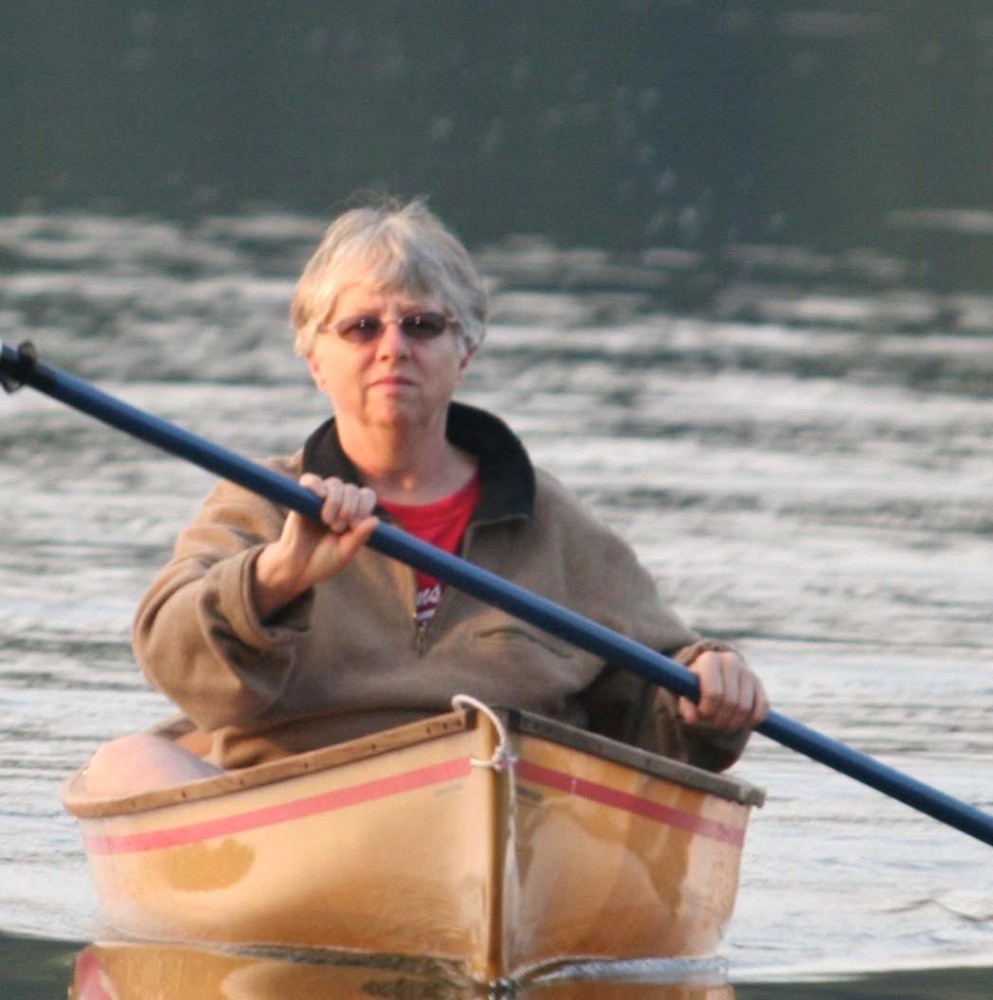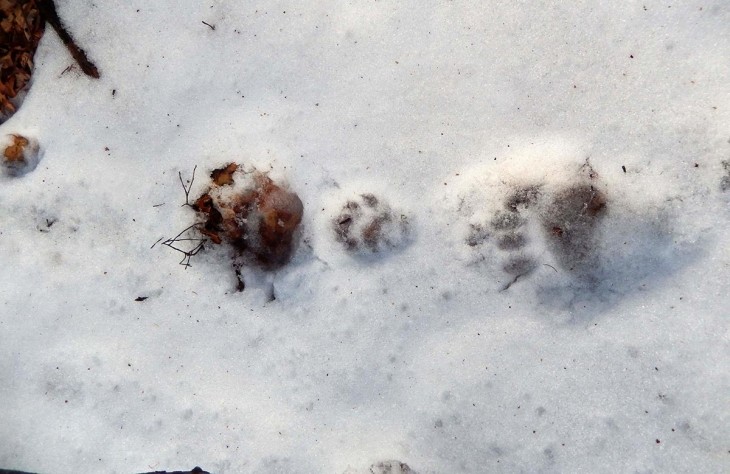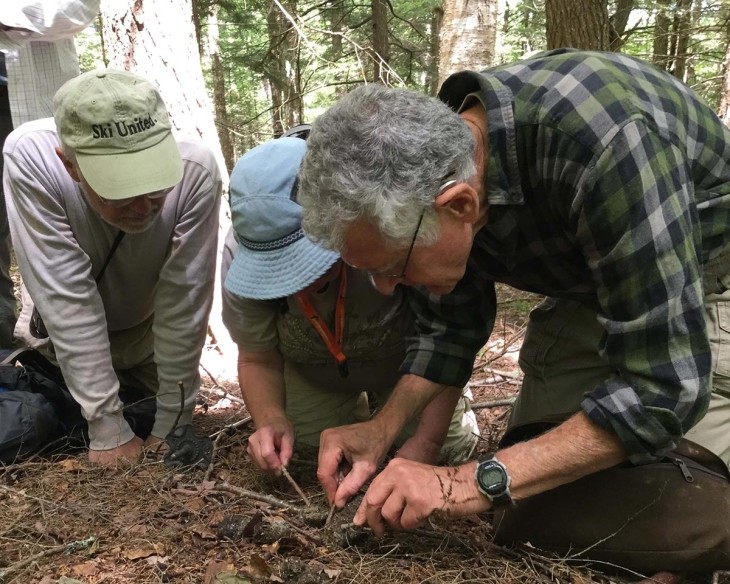Pat Liddle lives in Canaan, New York, in the foothills between the Hudson River and the Taconic Mountains. She formed a connection with the woods as a child and developed an interest in the natural world early on. For the past dozen years or so, Liddle has volunteered as a wildlife tracker in various tracking groups, work she says keeps her always learning new things. (She is on the planning committee for the Northeast Wildlife Tracker’s Conference.) She’s a retired teacher, construction worker, and insurance adjuster, a volunteer firefighter who also chairs the local fire district, and she holds various other volunteer roles in her community. When she’s not out in the woods or tending her garden, she may well be dressed in the Greylock Tartan, playing the bagpipes.
I grew up near Saratoga Springs, New York, in a town called Halfmoon. It’s named after the shape of the Mohawk River at that spot. I have so many good childhood memories of spending time outside, catching frogs and polliwogs in a pond on my parent’s property. Later, we moved to a house on the Mohawk River. Driftwood piled up and we made rafts and poled around à la Huck Finn and built forts and tree houses in the willow trees that grew along the shore. There was a very tall white pine, my favorite tree to climb, and with a great view.
What has served me well for my entire life is being interested in almost anything in the natural world, thanks to my Mom and Dad. As a family, we did a lot of camping in the Adirondacks, New England, and Eastern Canada. There’s nothing like a warm afternoon with the smell of balsam fir. We used a heavy, green canvas tent which had a distinctive smell. And even though my father would tell us not to touch the tent if it was raining, I couldn’t resist, with the resulting leak in my face as I lay in my sleeping bag.
I got started with tracking, thanks to Jane Winn, head of the Berkshire Environmental Action Team (BEAT) in Pittsfield, Massachusetts. As part of BEAT’s mission to improve environmental conditions in the Berkshires, she thought it would be helpful to have people who could use tracking to add depth to BEAT’s reports and collect data about how different wildlife uses these areas. I don’t quite remember how I connected with BEAT initially. I think [expert tracker and Northern Woodlands columnist] Sue Morse came and did a presentation at Berkshire Community College, and they were looking for people to sign up to do this tracking training. I was like, oh yeah, I want to do that. So that’s how I got more serious about it.
Our BEAT group went through training with Sue and her Keeping Track organization. That was in 2007, and BEAT continues to run a tracking group, led by Elia Del Molino. Having a group to go out with and learn with and from is great fun. There is always more to learn. At first, we would walk through the woods and say, I’d bet Sue Morse would see about 50 tracks and signs in the five feet that we’ve walked, and we haven’t seen one single thing that we think is important. But then you start noticing more. Part of it is getting the pattern of what you’re looking for, and then all of a sudden, you’re seeing it everywhere.
I’ve been serious about tracking since that training, but I dabbled around for as long as I can remember. I wasn’t serious about it until I was shown how to be serious about it. When I was learning tracking with Sue Morse, I’d go out and think, look at the track, look at all the details of the tracks or the sign. She makes you think about other things – you know, these animals eat, and the herbivores eat particular trees, and the black bears mark particular trees. So, you need to know botany, too. Tracking is more than just tracks in the snow or mud. Animal sign is all around. Nipped vegetation, chewed bark, animal runs and burrows. Are you in a field, spruce, hemlock, hardwood forest? It’s a whole universe out there, and you can never learn it all. Isn’t that great?
I lead a couple of tracking groups now with different organizations, as a volunteer. Teaching people is a really good way to hone your own skills, because you have to rethink your own knowledge. It helps to have to explain to other people why I think this particular track belongs to a bobcat or coyote or porcupine. People who do not have as extensive experience ask great questions, and I cannot assume all people have the same base information in their tracking background. It may be something as simple as how a rabbit or squirrel hops and the tracks that creates.
I think it’s important for anyone who wants to be out in the woods to see there’s a lot going on. If you want to go out tracking, don’t be talking with everybody, because you won’t see a thing. Tracking or, more usually, back tracking an animal means you need to feel comfortable getting off a trail. Most times I start off on a public trail, but once you start following the animal trail you need to keep your head about you in order to get back to a known area. Not that I haven’t been disoriented on occasion. To paraphrase Daniel Boone, “I have never been lost, but I will admit to being confused for several hours.”
You have to pay attention to everything you see. It’s not always easy, and I am willing to say it might be that, but I don’t know for sure. I look at tracks, and I think, well, maybe, but I need to look at a few more tracks, or I need to look at some other evidence to see if I can confirm my ID. Because tracks can look very similar depending on the substrate. A gray fox can look like a house cat, or a bobcat can look like a gray fox or like a red fox.
Recently, I was out with a group, and there was a very heated discussion about a trail being made by coyote. There were a few people insisting they were deer tracks. And I looked at them, and I could tell that they were coyote tracks. It’s the toenails – they can look just like deer tracks, depending on the snow and how much detail you can see. Then we went through this whole process. Let’s measure the distance between the tracks, the straddle, the stride and just look at the whole picture. It was a very logical process to determine they were coyote tracks, because the straddle and stride were just too short to be a deer. It was great.
Spending time in the woods is very calming to me, as I focus on various plants, tracks, animal signs, birds. It is a sensory overload sometimes, but in a good way. I am not thinking about the news, local or world or family. Just the woods. I usually bring a camera with me and a loupe – to look at chew marks on an acorn, a flower part, or that crab spider in the goldenrod. Just little things. I’ll bring a ruler, so if I take a photo of a track, I place it in the photo to have scale. I also bring a laminated card with different tracks, stride, and straddle.
I always liked the bagpipes when I was young. When I was doing construction, I went in to talk over a job with somebody, and there was a picture of him in his Scottish regalia on the wall. I asked him about it, and he said he was a member of a band in Pittsfield. I started going to band practice, took lessons, and continue to learn as I play the pipes. It’s not an instrument that gives you immediate gratification.
Like tracking there is always something new to learn; you will never know it all. Now I play with the same band, the Berkshire Highlanders Pipes and Drums. The band plays in parades and graduations, and we do concerts during warmer months. We have also played with the Boston Pops, Tanglewood on Parade, and Prairie Home Companion. We have our own tartan, called the Greylock Tartan, named for Mount Greylock [the highest point in Massachusetts]. We play a concert on top of Mount Greylock every summer. It’s very Scottish up there when the mists come in.
One of my favorite quotes is by Ernest Thompson Seton: “Never forget the trail, look ever for the track in the snow; it is the priceless, unimpeachable record of the creature’s life and thought, in the oldest writing known on the earth.”






Discussion *